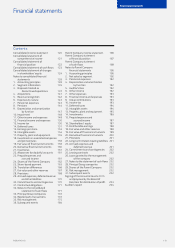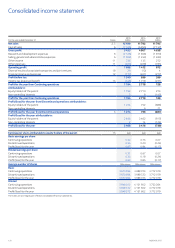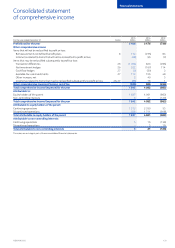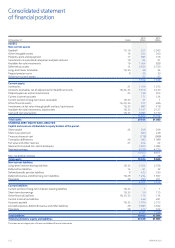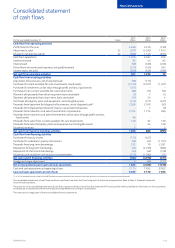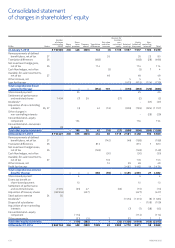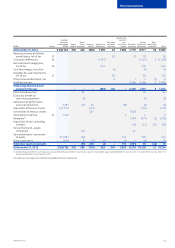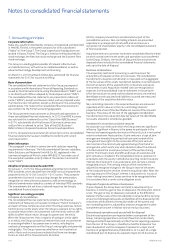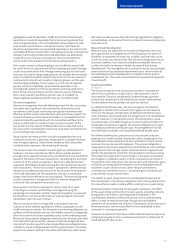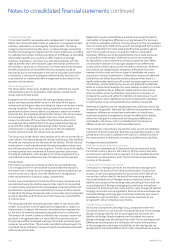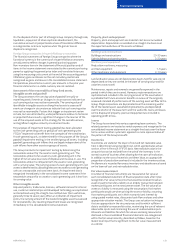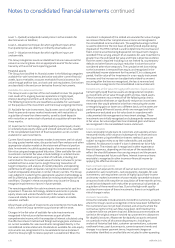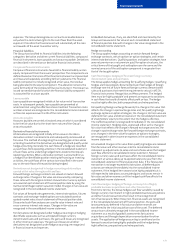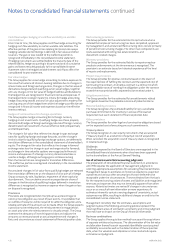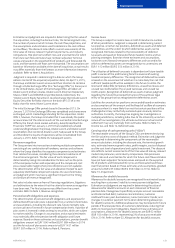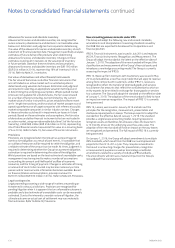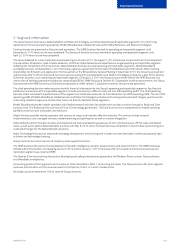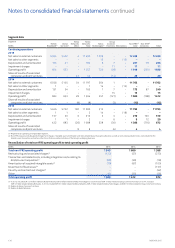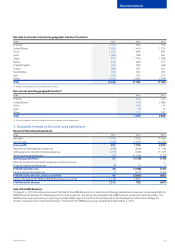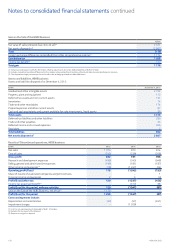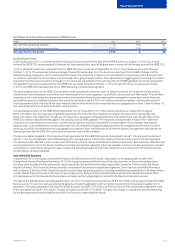Nokia 2015 Annual Report Download - page 131
Download and view the complete annual report
Please find page 131 of the 2015 Nokia annual report below. You can navigate through the pages in the report by either clicking on the pages listed below, or by using the keyword search tool below to find specific information within the annual report.
129
Financial statements
NOKIA IN 2015
On the disposal of all or part of a foreign Group company through sale,
liquidation, repayment of share capital or abandonment, the
cumulative amount or proportionate share of translation dierences
isrecognized as income or expense when the gain or loss on
disposalisrecognized.
Foreign Group companies in hyperinationary economies
The nancial statements of foreign Group companies where the
functional currency is the currency of a hyperinationary economy
areadjusted to reect changes in general purchasing power.
Non-monetary items in the statement of nancial position and all
items in the income statement are restated to the current purchasing
power by applying the general price index and translated into euro
using the measuring unit current at the end of the accounting period.
Inationary gains and losses on the net monetary position are
recognized as gains and losses in the consolidated income statement.
Comparatives presented as current year amounts in the prior year
nancial statements in a stable currency are not restated.
Assessment of the recoverability of long-lived assets,
intangibleassets and goodwill
The Group assesses the carrying value of goodwill annually or
morefrequently if events or changes in circumstances indicate that
such carrying value may not be recoverable. The carrying value of
identiable intangible assets and long-lived assets is assessed if
events or changes in circumstances indicate that such carrying value
may not be recoverable. Factors that trigger an impairment review
include, but are not limited to, underperformance relative to historical
or projected future results, signicant changes in the manner of the
use of the acquired assets or the strategy for the overall business,
andsignicant negative industry or economic trends.
For purposes of impairment testing, goodwill has been allocated
tothecash-generating units or groups of cash-generating units
(“CGUs”) expected to benet from the synergies of the combination.
Acash-generating unit, as determined for the purposes of the Group’s
goodwill impairment testing, is the smallest group of assets, including
goodwill, generating cash inows that are largely independent of the
cash inows from other assets or groups of assets.
The Group conducts its impairment testing by determining the
recoverable amount for the asset or cash-generating unit. The
recoverable amount of an asset or a cash-generating unit is the
higherof its fair value less costs of disposal and its value-in-use. The
recoverable amount is compared with the asset or cash-generating
unit’s carrying value. The carrying value of a cash-generating unit’s net
assets is determined by allocating relevant net assets to cash-generating
units on a reasonable and consistent basis. An impairment loss is
recognized immediately in the consolidated income statement if the
recoverable amount for an asset or a cash-generating unit is less than
its carrying value.
Other intangible assets
Acquired patents, trademarks, licenses, software licenses for internal
use, customer relationships and developed technology are capitalized
and amortized using the straight-line method over their useful lives,
generally three to seven years. When an indication of impairment
exists, the carrying amount of the related intangible asset is assessed
for recoverability. Any resulting impairment losses are recognized
immediately in the consolidated income statement.
Property, plant and equipment
Property, plant and equipment are stated at cost less accumulated
depreciation. Depreciation is recorded on a straight-line basis over
theexpected useful lives of the assets as follows:
Buildings and constructions
Buildings and constructions 20–33 years
Light buildings and constructions 3-20 years
Machinery and equipment
Production machinery, measuring
and test equipment 1-5 years
Other machinery and equipment 3-10 years
Land and water areas are not depreciated. Assets held for sale are not
depreciated as they are carried at the lower of carrying value and fair
value less costs to sell.
Maintenance, repairs and renewals are generally expensed in the
period in which they are incurred. However, major renovations are
capitalized and included in the carrying amount of the asset when it
isprobable that future economic benets in excess of the originally
assessed standard of performance of the existing asset will ow to the
Group. Major renovations are depreciated over the remaining useful
life of the related asset. Leasehold improvements are depreciated
overthe shorter of the lease term and the useful life. Gains and losses
on the disposal of property, plant and equipment are included in
operating prot or loss.
Leases
The Group has entered into various operating lease contracts. The
related payments are treated as rental expenses and recognized in the
consolidated income statement on a straight-line basis over the lease
terms unless another systematic approach is more representative of
the pattern of the Group’s benet.
Inventories
Inventories are stated at the lower of cost and net realizable value.
Cost is determined using standard cost, which approximates actual
cost on a rst-in rst-out (“FIFO”) basis. Net realizable value is the
amount that can be realized from the sale of the inventory in the
normal course of business after allowing for the costs of realization.
Inaddition to the cost of materials and direct labor, an appropriate
proportion of production overhead is included in the inventory values.
An allowance is recorded for excess inventory and obsolescence based
on the lower of cost and net realizable value.
Fair value measurement
A number of nancial instruments are measured at fair value at
eachconsolidated statement of nancial position date after initial
recognition. Fair value is the price that would be received to sell an
asset or paid to transfer a liability in an orderly transaction between
market participants at the measurement date. The fair value of an
asset or a liability is measured using the assumptions that market
participants would use when pricing the asset or liability, assuming
that market participants act in their economic best interest by
usingquoted market rates, discounted cash ow analyses and other
appropriate valuation models. The Group uses valuation techniques
that are appropriate in the circumstances and for which sucient
datais available to measure fair value, maximizing the use of relevant
observable inputs and minimizing the use of unobservable inputs.
Allassets and liabilities for which fair values are being measured or
disclosed in the consolidated nancial statements are categorized
within the fair value hierarchy, described as follows, based on the
lowest level input that is signicant to the fair value measurement
asawhole:


